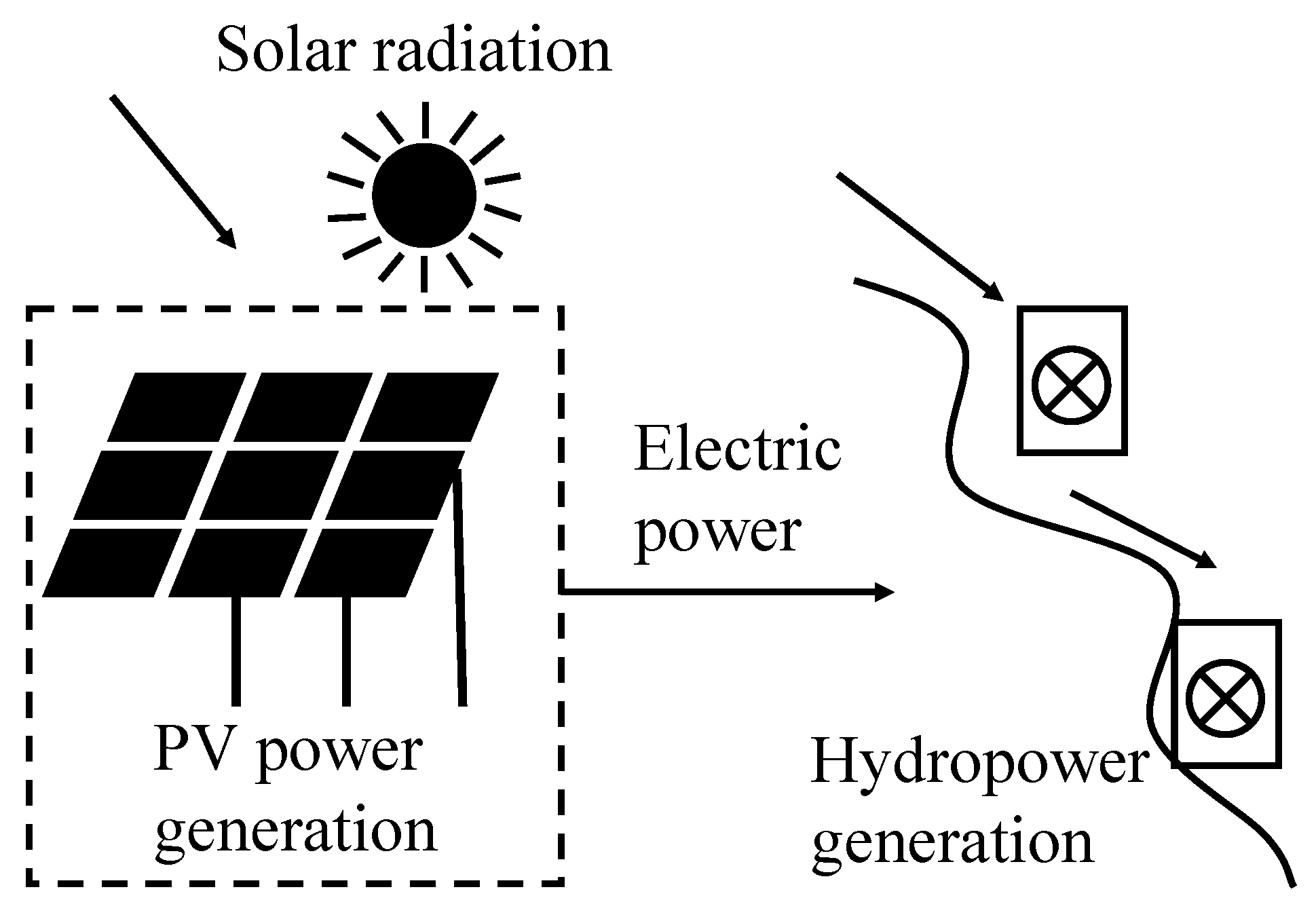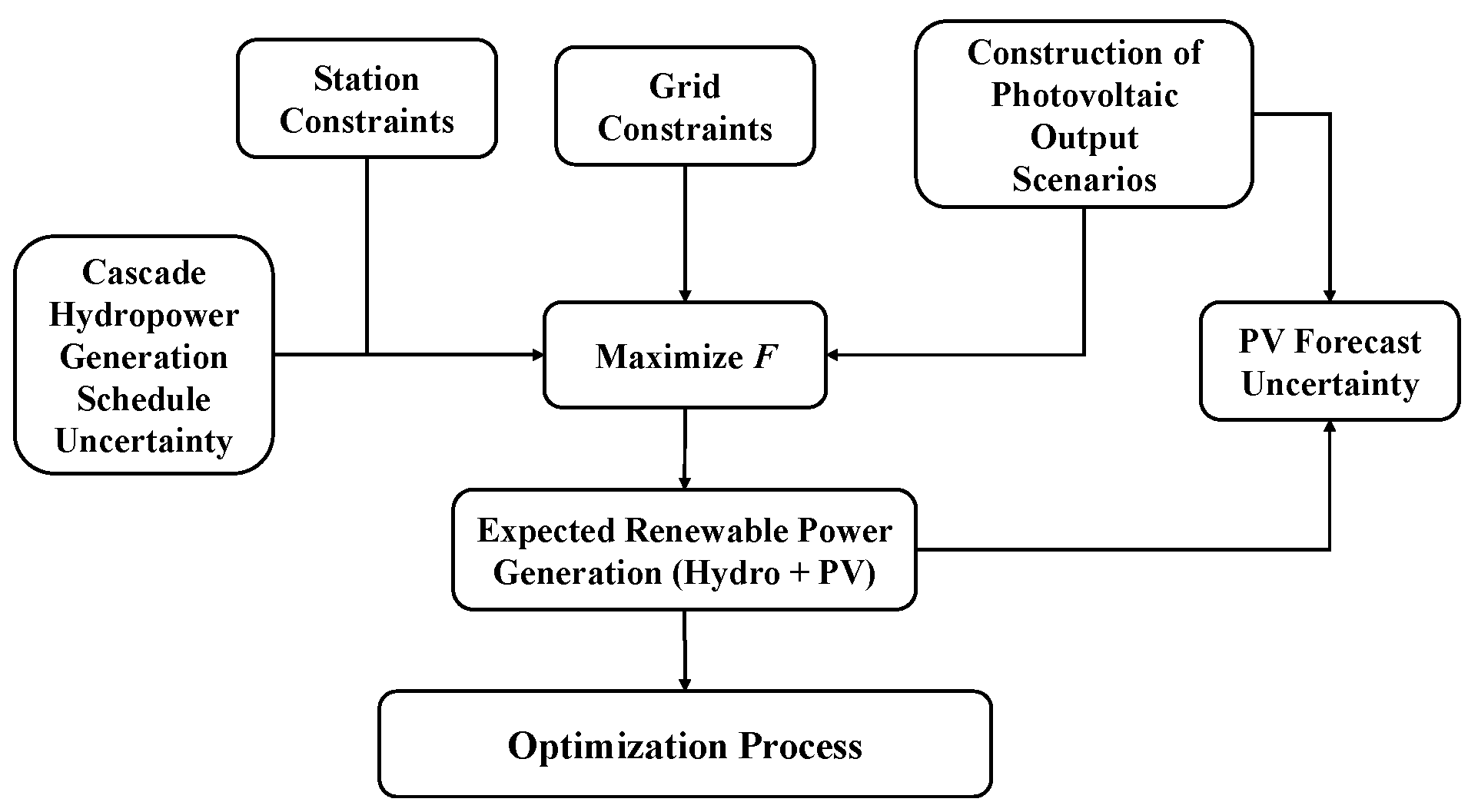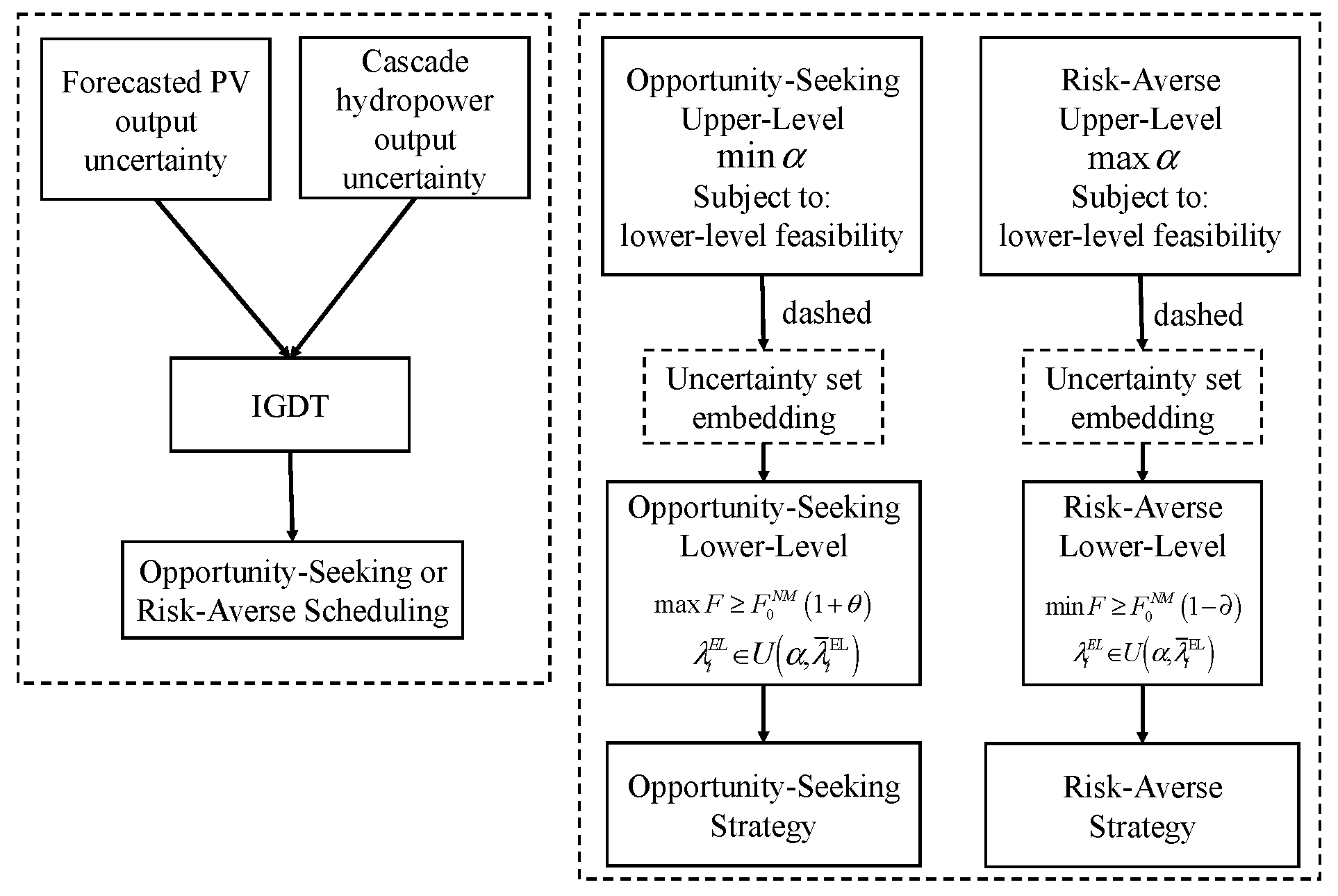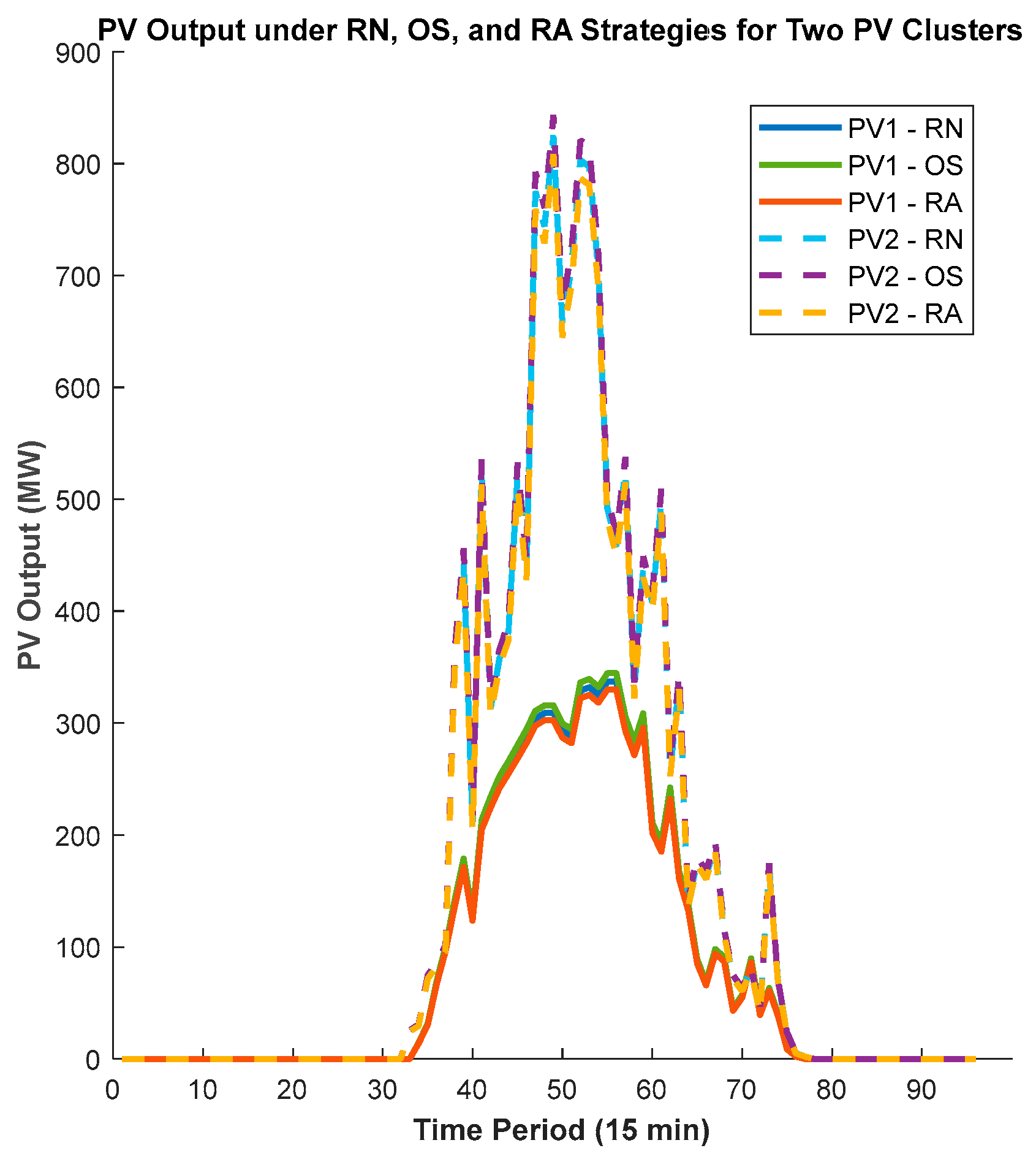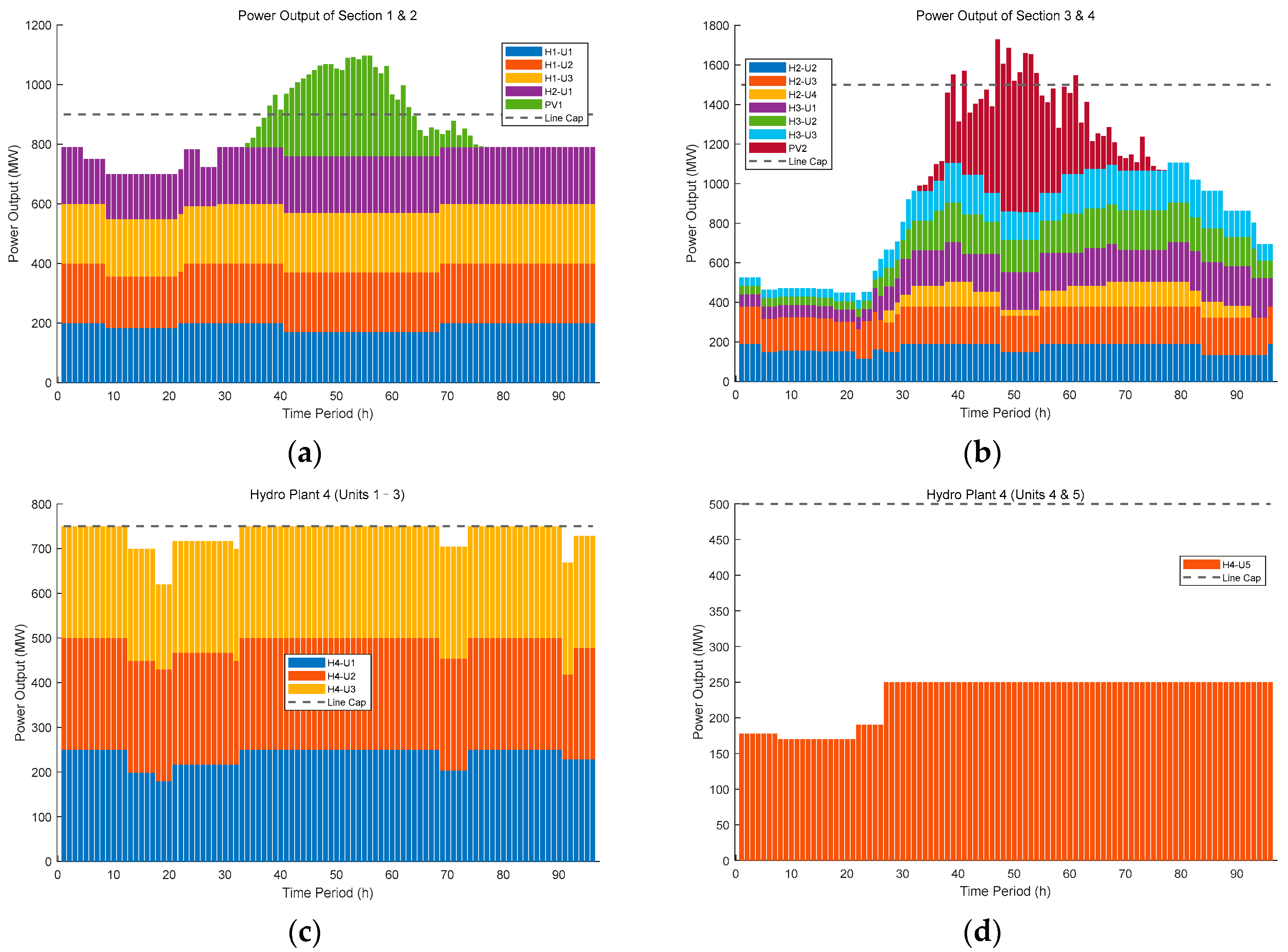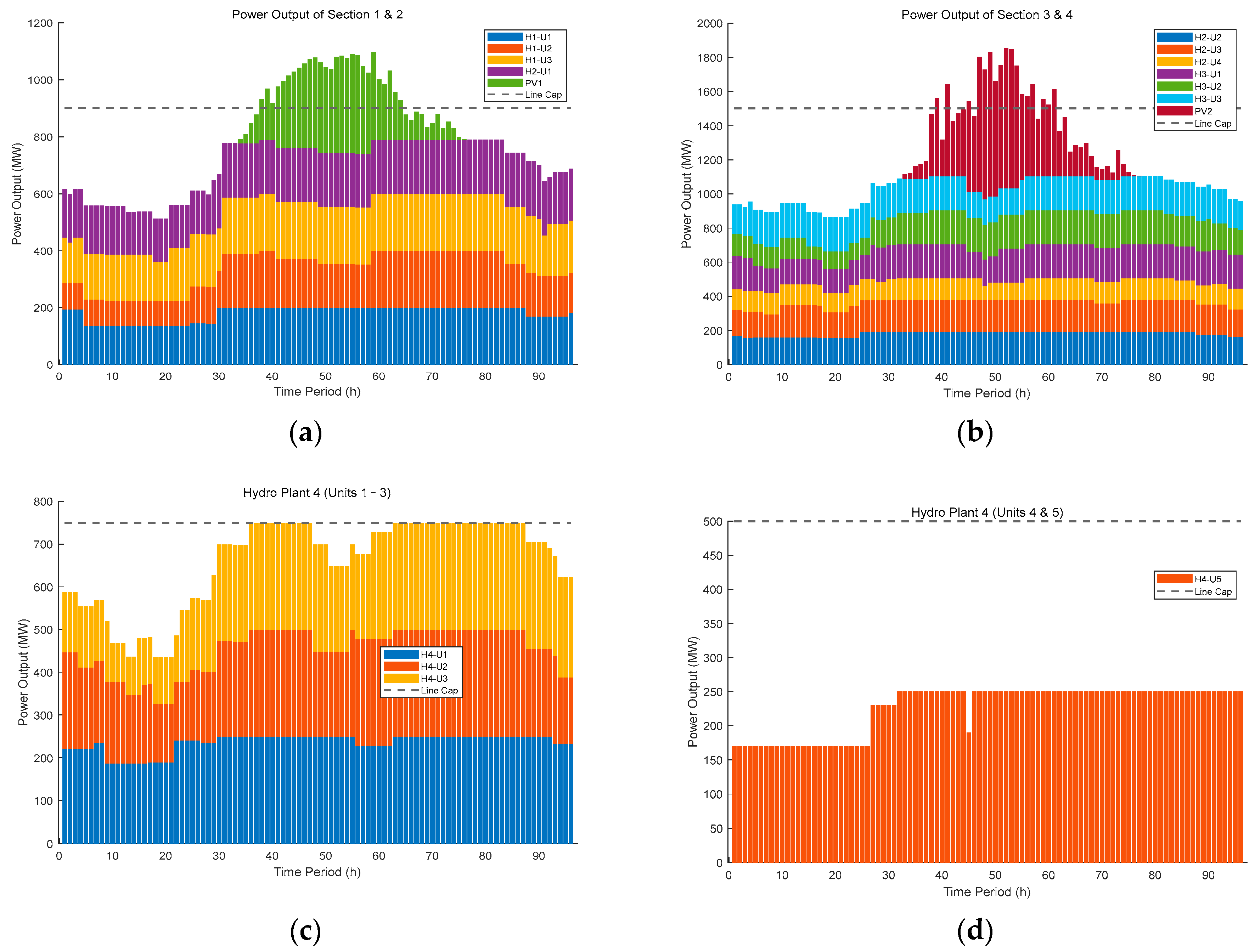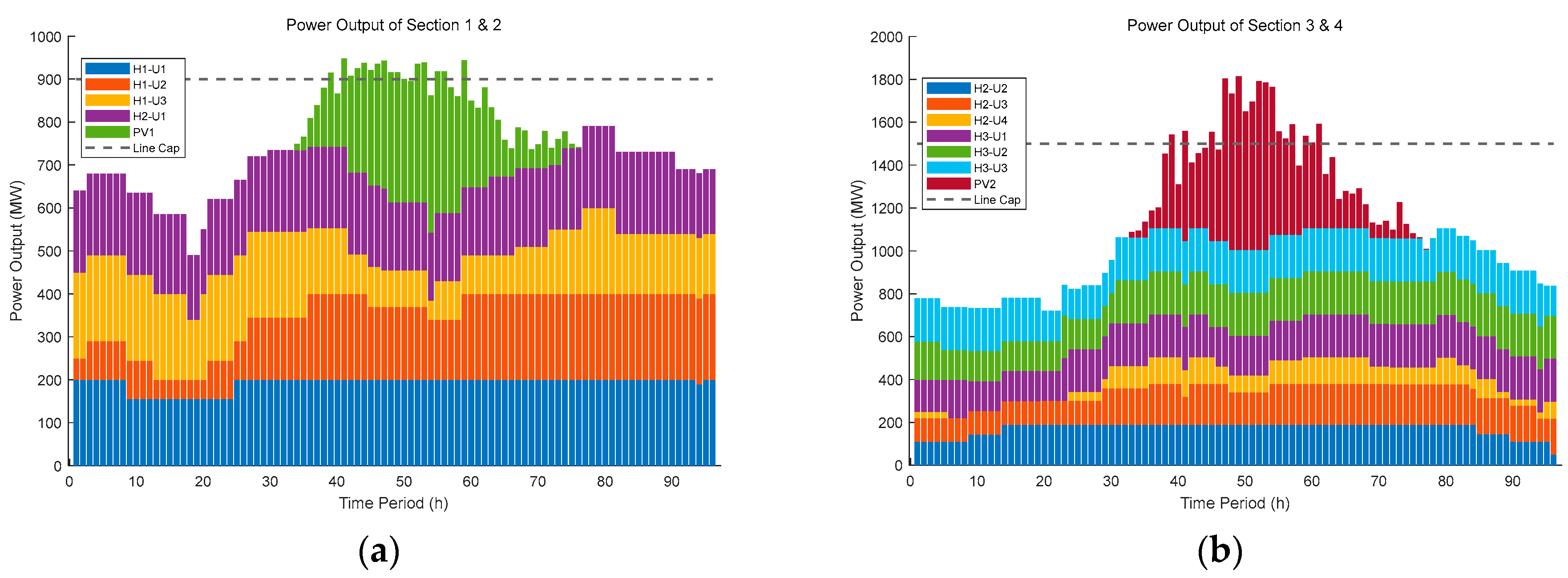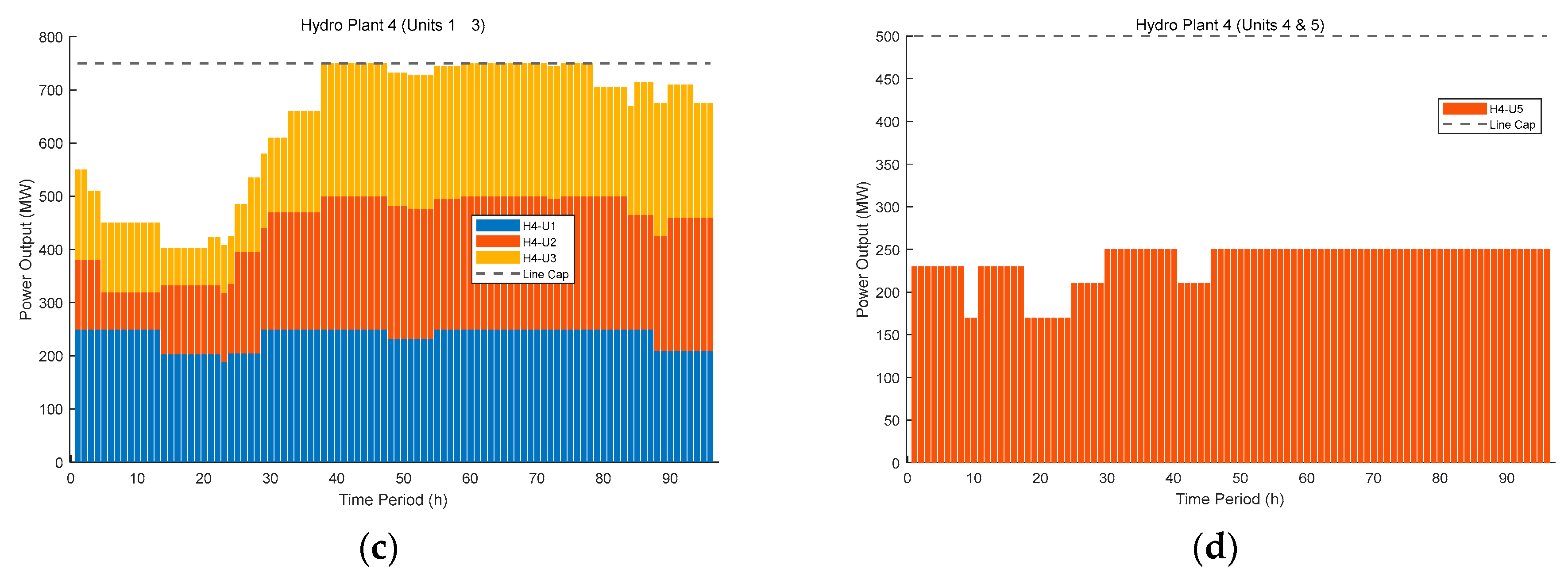1.2.1. Renewable Energy Systems (Hydropower + PV)
This section reviews scheduling models for renewable energy systems, focusing on the integration of hydropower and PV systems, as well as hybrid configurations involving wind and energy storage. Due to its operational flexibility, hydropower serves as a natural complement to the intermittent nature of PV generation. Numerous studies have explored coordinated dispatch strategies to enhance system efficiency and reliability under uncertainty. Luo et al. [
11] developed a short-term optimization model for cascade hydro–PV systems using MILP, aiming to maximize renewable energy utilization and minimize curtailment. Song [
12] applied fuzzy clustering means (F-CM) and scenario analysis to account for PV uncertainty, thereby improving system stability and dispatch reliability. Zhao et al. [
13] proposed a multi-objective optimization model using the Copula–Monte Carlo method, which captures the joint output characteristics of PV and hydropower to support clean energy consumption and peak shaving. In their model, peaking is achieved by minimizing the average deviation in residual load across multiple zones. Nonetheless, earlier approaches predominantly rely on deterministic or scenario-based approaches with limited probabilistic representation, often assuming simplified system structures and static risk preferences. These limitations restrict their applicability to large-scale, real-world cascade operations.
To enhance flexibility beyond conventional hydro–PV configurations, emerging storage technologies have attracted attention. Wu et al. [
14] developed a day-ahead IGDT-based scheduling model for wind and gravity energy storage (GES), reformulating a bi-level risk model into a tractable single-level framework, which enabled economically efficient scheduling under both price and wind uncertainties. While this reformulation improves tractability, such approaches are rarely extended to hydro–PV systems with multi-timescale coupling and spatial heterogeneity.
Concurrently, a number of studies have further explored complementary aspects that are closely related to the design and operation of hydropower PV systems, including physical safety constraints and infrastructure limitations. Xiong et al. [
15] introduced a vibration-avoidance strategy in hydro–wind–PV configurations, where hydropower served as the stabilizing anchor, ensuring safe turbine operation while optimizing generation and maintaining system stability across multiple simulation scenarios. Zhang et al. [
16] proposed a multi-objective planning model centered on hydro–PV integration, which combines PV sizing with power transmission capacity design to directly address curtailment issues and enhance carbon mitigation.
Yet, most of these models focus on technical feasibility rather than comprehensive risk analysis and often overlook dynamic environmental conditions or hydrological uncertainty. Additionally, Li and Qiu [
17] proposed a long-term multi-objective model for hydro–PV systems, using decoupled timescales and a modified NSGA-II algorithm to validate hydropower’s compensatory role under variable solar conditions. Wang et al. [
18] developed a two-stage robust day-ahead scheduling model for hydro–PV systems, using an ambiguity set to describe PV uncertainty and improve dispatch adaptability and power balance. These models focus on long-term planning and enhancing day-ahead scheduling robustness.
However, they may not fully consider operational risk attitudes or permit the flexible adjustment of robustness levels in response to different decision-maker preferences. Lu et al. [
19] focused on medium- to long-term scheduling for cascade hydro–PV systems, using an improved interval optimization (IO) technique to handle uncertainties in hydrological inflow and PV output. This model enhanced system robustness and economic performance while reducing curtailment. Lei et al. [
20] established a dual-layer optimization architecture for hydro–wind–PV hybrid systems under wind and solar uncertainty. They introduced a synchronous peak shaving strategy and a λ-flow iteration method, achieving a 95.53% peak shaving rate and improving economic efficiency. In this model, peak shaving refers to minimizing temporal fluctuations in residual load—defined as the system load minus renewable generation—over time and across scenarios.
Still, these efforts are largely scenario-dependent and may suffer from scalability issues when applied to systems with large spatiotemporal variability. Fan et al. [
21] developed a stochastic multi-objective optimization model for wind–solar–hydro hybrid systems, considering generation and demand-side uncertainties. Their approach improved net profit and reduced the fluctuation in the remaining load, improving grid balance and system reliability. Li et al. [
22] proposed a short-term optimal scheduling strategy for hydro–wind–solar systems based on deep learning and a two-layer nested optimization framework, effectively managing renewable generation uncertainty and maximizing energy storage benefits. Zhang et al. [
23] introduced a hydro–PV capacity planning framework that bridges temporal operational scales, identifying optimal PV sizing under different curtailment thresholds and improving resource utilization in cascade hydro–PV systems. Although these hybrid frameworks show strong performance in simulations, many rely on machine learning models that may require extensive historical data and lack robustness guarantees under severe forecast errors.
1.2.2. Multi-Energy System Integration and Uncertainty
The integration of multi-carrier energy systems under uncertainty has prompted the development of various optimization strategies aimed at managing operational risks and improving system performance. Coordinating renewable energy sources like wind, solar, and hydropower is essential for increasing the reliability and flexibility of power systems.
To this end, recent studies have proposed scheduling models that incorporate multi-timescale operation and robust optimization techniques. Li et al. [
24] proposed a market-oriented scheduling framework for a wind–solar–hydro–storage consortium, which balances long-term contract execution with short-term uncertainty. This approach optimized energy resource scheduling across multiple timescales, ensuring efficient integration while mitigating uncertainty impacts. Li et al. [
25] implemented a bio-inspired Moth-Flame Optimization (MFO) algorithm for multi-objective optimization for hydro–solar systems, targeting enhanced power generation and capacity utilization through flexible and adaptive scheduling. Gong et al. [
26] pioneered a chance-constrained robust optimization approach for PV–storage networks, employing probabilistic source-load uncertainty modeling to maintain cost-effectiveness in active distribution systems. Similarly, Zhou et al. [
27] formulated a dual-stage robust optimization paradigm for low-carbon energy integration, successfully reconciling economic and environmental objectives under carbon policy uncertainties. Huang et al. [
28] enhanced hydro–solar system flexibility by a day-ahead scheduling model incorporating a coupled cloud model and hierarchical compensation strategies, thereby reducing PV curtailment and improving hydropower adaptability to solar fluctuations. Shi et al. [
29] explored the integration of solar-powered compressed air energy storage (SPCAES) in a multi-energy hub, applying the IGDT with a risk-averse strategy and the Elephant Herd Optimization (EHO) algorithm to achieve 15% cost savings and 20% revenue enhancement during peak demand periods.
However, many of these models rely on specific forecasting methods or assume perfect coordination among subsystems, which may limit their scalability and practical deployment. Building on these frameworks, other studies have focused on enhancing long-term system flexibility under broader uncertainty scenarios. Shi et al. [
30] investigated a hybrid cascade hydro–wind–PV–battery system under uncertain load growth, proposing a two-stage stochastic optimization model based on scenario analysis. This approach supported cost-effective system planning while capturing the long-term impacts of uncertainty. Tian et al. [
31] formulated a cross-regional hydro–wind–PV scheduling model that simultaneously optimized power curtailment, load shedding, and generation stability, ensuring compliance with multi-regional grid requirements and maintaining operational stability. In parallel, Tang et al. [
32] enhanced the Input–Output (IO) method for cascade hydro–PV systems, addressing uncertainties in inflow runoff and photovoltaic power output, improving system robustness and reducing curtailment. Tan et al. [
33] devised operational rules for hybrid pumped-storage hydropower–PV systems, reconstructed from conventional cascade stations. By incorporating long-distance transmission constraints and PV forecast uncertainty, their model improves generation profits, regulation capacity, and risk management, facilitating the transition to more flexible multi-energy integration.
Nevertheless, many scenario-based approaches rely heavily on predefined distributions or lack real-time adaptability, which can affect performance under highly volatile conditions. More recent efforts have further extended this line of research into the domain of market participation and real-time dispatch. Li et al. [
34] proposed a Wasserstein-metric-based chance-constrained model for hydro–solar–pumped storage systems in electricity markets, optimizing contract fulfillment and day-ahead bidding under dual-price and generation uncertainty. Finally, Tan et al. [
35] implemented a three-layer (day-ahead/intraday/real-time) risk-averse strategy for hydro–PV–storage systems, utilizing battery storage to mitigate forecast errors in the Longyangxia project, thereby improving generation safety and operational flexibility. Li et al. [
36] applied Nash bargaining and ADMM decomposition to coordinate wind–PV–pumped storage–hydropower systems across energy and ancillary service markets, achieving a 20% increase in renewable utilization through fair revenue allocation. However, these models often assume ideal communication among market participants and may overlook practical limitations such as market volatility, data delays, and system inertia.
In order to systematically compare recent advances in multi-energy dispatch under uncertainty,
Table 1 summarizes representative studies in terms of optimization models, uncertainty-handling techniques, and modeling scope. These references cover a variety of risk-aware strategies, including the IGDT, DRCC, scenario-based stochastic optimization, and market-oriented coordination.
1.2.3. Information Gap Decision Theory in Energy Systems
The IGDT has been increasingly adopted in energy systems to support robust decision-making under severe uncertainty, where traditional probabilistic models often fall short. The IGDT enables the formulation of adaptive strategies by quantifying the trade-offs between robustness and performance, accommodating both risk-averse and risk-seeking decision preferences. Sun et al. [
37] proposed a hybrid stochastic programming-IGDT model for Integrated Energy Systems (IESs), addressing uncertainties in PV and hydropower generation. Their approach enables flexible dispatch strategies by incorporating multiple risk attitudes, providing a more adaptable solution for uncertain energy production. Ding et al. [
38] extended the IGDT to a complementary energy system that integrates P2G, CCS, and CHP technologies, improving operational robustness in multi-energy configurations. Similarly, Liu et al. [
39] applied the IGDT to multi-energy retailers (MERs), incorporating the demand response for electricity, gas, and heat under price uncertainty, and developed adaptive scheduling plans tailored to different risk preferences. Zhu et al. [
40] proposed a robust long-term optimization framework for hydro–PV hybrid systems. Although they did not explicitly use the IGDT, their model integrated a multi-objective evolutionary algorithm with stochastic multi-criteria analysis (SMAA-FOS), demonstrating the utility of robust decision-making under forecast uncertainty. This model improved economic performance and operational stability, aligning closely with the IGDT principles.
Recent advancements have focused on expanding the applicability of the IGDT across various energy systems. Phu et al. [
41] developed an IGDT-based normalized weighted-sum (IGDT-NWS) model for an integrated energy hub (IEH), which includes renewables, biomass-to-hydrogen electrolysis, hybrid storage, and hydrogen market interaction. This method considers uncertainties in energy demand, prices, and renewable generation, leading to improvements in cost efficiency, emissions reduction, and energy export metrics. Ji et al. [
42] introduced the Comprehensive Risk Strategy–IGDT (CRS-IGDT) for park-level IESs, allowing dynamic adaptation between risk-averse and risk-seeking strategies via an adaptive step ratio and a comprehensive risk cost function. Wu et al. [
43] designed a bi-level IGDT-based integrated demand response (IDR) model for IESs acting as price makers in electricity and gas markets, integrating uncertainty management with game-theoretic bidding and privacy-preserving algorithms. Yin et al. [
44] proposed an entropy-weighted NSGA-II enhanced IGDT model (EWNS-IGDT) for high-altitude electric–heat–oxygen integrated systems (EHO-IESs), improving uncertainty quantification and significantly reducing costs and emissions. These studies demonstrate how the IGDT is becoming a vital tool for improving the robustness and flexibility of energy systems by integrating multiple energy sources and managing complex uncertainties.
1.2.4. Research Gaps and Unmet Needs
Although considerable progress has been made in the scheduling of hydro–PV and multi-energy systems, several critical limitations remain. Most existing models rely on deterministic or scenario-based probabilistic approaches, which inadequately capture epistemic uncertainty in PV generation and thus tend to underestimate operational risks [
11,
12,
26]. While robust optimization techniques such as the IGDT have been introduced to address deep uncertainty [
37,
39], their application in large-scale cascade hydro–PV systems—particularly those involving spatial and temporal coupling—remains limited [
14,
36].
It is widely acknowledged that hydropower acts as a foundational stabilizing component in hybrid energy systems, enabling effective peak load balancing and ancillary service provision [
17,
18,
22]. However, the optimal utilization of this flexibility remains constrained by the incomplete modeling of system dynamics. In particular, storage degradation, transmission bottlenecks, and energy conversion losses are often oversimplified or omitted, undermining dispatch accuracy and long-term operational robustness [
15,
16,
29].
Moreover, the representation of decision-makers’ risk preferences remains underexplored. While some models incorporate risk-averse or robust strategies [
19,
41], few allow adaptive control over robustness levels or support diverse risk attitudes—such as risk-neutral, opportunity-seeking, and conservative approaches—that align with realistic policy and investment behaviors [
18,
37,
42]. Although the IGDT is conceptually well-suited for such applications, its practical use is often hindered by bi-level formulation complexity and the lack of tractable reformulations.
In addition, data-driven methods, including deep learning and metaheuristics, have enhanced prediction accuracy and computational efficiency [
22,
25]. However, these methods often suffer from limited interpretability and generalizability, particularly under non-stationary conditions, such as climate anomalies or market volatility [
33,
44]. Moreover, while market-oriented scheduling frameworks have gained traction [
34,
36], many rely on the idealized assumptions of subsystem coordination and information availability—conditions that rarely hold in practice due to latency, data asymmetry, or strategic market behavior.
These limitations underscore the urgent need for risk-aware scheduling models that (i) explicitly account for forecast uncertainty, (ii) flexibly represent different risk attitudes, and (iii) remain computationally tractable under real-world operational constraints.
